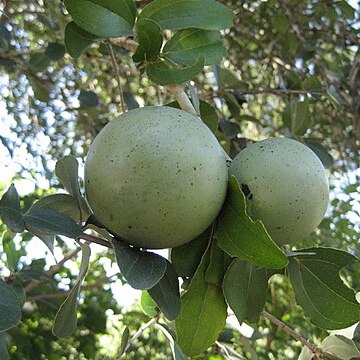It can be a bush or a tall spineless tree. It can have one or many stems. They can grow to 15 m high. It loses its leaves during the year. The leaves are in opposite pairs. They are 2-9 cm long by 1.3-6 cm wide. They are oblong and narrow to the base. The leaves are thickish. The flowers are small and yellow. They are borne in bunches in the axils of leaves or on old wood. The fruit are large. They can be 4-10 cm across and round. They have a hard woody shell. They are blue-green but become yellow-brown when ripe. There are a large number of flat seeds. These are in a pleasant tasting pulp.
This subspecies is characterised by the trees being up to 8 m tall with a widely spreading canopy, the branchlets being, usually, rather thick, smooth, brown or dark grey, distinctly lenticelled, and bearing short contracted lateral branchlets with congested prominent leaf-scars; the leaves mostly obovate-oblong, suborbicular or oblongelliptic, 2-8 cm long and 1-4.2 cm broad, densely to sparsely pubescent on both surfaces or at least on the veins beneath, rarely glabrous; the inflorescence not pedunculate; and the flowers only about 5 mm long.
Corolla in the mature bud (1·8)2·8–3·3(3·6) times as long as the calyx, (4·5)5–8 mm. long, white or greenish–yellow, glabrous outside, inside with a brush–like ring of white lanate hairs in the throat and just on the base of the lobes; tube cylindrical or nearly so (1)1·2–1·8(2·2) times as long as the calyx, 0·7–1·7 x as long as the lobes, 2·5–4·5(5) mm. long, 1·5–2·8 mm. wide at the throat; lobes thick, narrowly triangular, 1·5–3 times as long as wide, 2–3·6 x 1–1·9 mm., acute or subacute, spreading.
Fruit orange or yellow, nearly mature bluish–green, large or sometimes rather small, hard when not small, globose, 2–8(10) cm. in diam., with about 5–50 seeds, with somewhat granular skin, slightly shining. Wall mostly thick, (1)2–4 mm. thick, thicker above the pedicel, brittle in mature fruits, hard and not broken by hand when nearly mature and/or dry. Pulp orange, slimy, edible.
Pistil hirto–pilose in the middle, (3·5)4–6 mm. long; ovary narrowly ovoid or oblong, 1·5–3 x 0·8–1·5 mm., hirto–pilose at the very apex, further glabrous, often with a disc–like base, gradually narrowed into the style, 2–celled; style thick (2)2·5–4 mm. long, at the base hairy like the ovary at the apex; stigma capitate.
Sepals pale green, free or nearly so, subequal, the inner slightly smaller, ovate, broadly ovate or suborbicular, 1–1·6 times as long as wide, 1·7–2·5(3) x 1·5–2·2 mm., rounded or obtuse at the apex, ciliate, glabrous or with some minute appressed hairs at the base inside, without colleters.
Seeds pale ochraceous, flattened or not, often more or less plano–convex, obliquely ovate, elliptic, or tetrahedral, usually irregularly curved, 1–4–1–8 times as long as wide, 11–25 x 6–18 x 5–8 mm., with thick very short erect hairs, rather rough.
Shrub or tree, 3-15 m high. Leaves rounded at apex. Inflorescence lateral. Ovules innumerable. Fruit large, from 40-100 mm in diameter, many-seeded, rind thick and woody. Flowers greenish white or greenishyellow.
Inflorescences axillary or ramiflorous, usually several together, very short and nearly fasciculate, 1 x 1·2 x 1·5 cm., 1·2 x branched, few–flowered. Peduncle, branches, and pedicels short or very short.
Stamens hardly exserted; filaments extremely short, inserted at the mouth of the corolla tube; anthers oblong, about twice as long as wide, 1·2–1·8 x 0·6–0·8 mm., glabrous.
Branches pale grey to dark brown, powdery or not, lenticellate or not, smooth; branchlets glabrous or pubescent, terete.
Often many–stemmed and much–branched shrub or small tree, 1·50–10(20) m. high, deciduous.
Bark mostly pale grey or greyish–white, smooth; wood whitish.
Trunk 7–60 cm. in diam., mostly branched from low down.
In each cell 5–30 ovules.
Flowers 4–merous.


